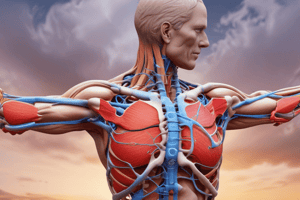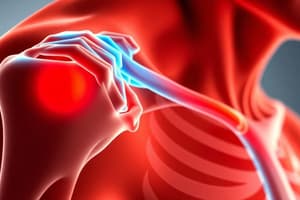Podcast
Questions and Answers
What is the primary position described that may lead to rotator cuff compression?
What is the primary position described that may lead to rotator cuff compression?
- Abduction, slight flexion, and external rotation
- Adduction, slight flexion, and external rotation
- Adduction, slight extension, and internal rotation
- Abduction, slight flexion, and internal rotation (correct)
Which of the following statements is true regarding the critical area for impingement?
Which of the following statements is true regarding the critical area for impingement?
- It is considered to have minimal clinical significance.
- It is located about 5 cm proximal to the insertion of the supraspinatus tendon.
- It exhibits increased vascularity compared to surrounding areas.
- It is located about 1 cm proximal to the supraspinatus tendon insertion. (correct)
Which age group is most commonly associated with Stage 1 of subacromial impingement syndrome?
Which age group is most commonly associated with Stage 1 of subacromial impingement syndrome?
- Patients generally 20 years old
- Patients generally 50 years old
- Patients generally 40 years old (correct)
- Patients generally 30 years old
What symptom is commonly associated with overhead activity in SIS?
What symptom is commonly associated with overhead activity in SIS?
Which specialty test is NOT mentioned as sensitive for diagnosing SIS?
Which specialty test is NOT mentioned as sensitive for diagnosing SIS?
Which finding typically indicates chronic impingement in patients?
Which finding typically indicates chronic impingement in patients?
Which statement regarding plain radiographs in SIS is true?
Which statement regarding plain radiographs in SIS is true?
What is one possible characteristic of pain in SIS?
What is one possible characteristic of pain in SIS?
What is the primary purpose of musculoskeletal ultrasound in shoulder evaluation?
What is the primary purpose of musculoskeletal ultrasound in shoulder evaluation?
What signifies a positive drop arm test?
What signifies a positive drop arm test?
Which condition is commonly associated with restricted motion and may have a history of recent shoulder injury or surgery?
Which condition is commonly associated with restricted motion and may have a history of recent shoulder injury or surgery?
What is a crucial part of the management for patients with subacromial impingement syndrome (SIS) after three months of conservative treatment?
What is a crucial part of the management for patients with subacromial impingement syndrome (SIS) after three months of conservative treatment?
What common feature may MRI reveal in patients with adhesive capsulitis?
What common feature may MRI reveal in patients with adhesive capsulitis?
Which of the following treatments is recommended for reducing acute swelling in shoulder injuries?
Which of the following treatments is recommended for reducing acute swelling in shoulder injuries?
What age group commonly develops chronic rotator cuff tears?
What age group commonly develops chronic rotator cuff tears?
What is the appropriate course of action if a patient with shoulder pain has not improved after six weeks of acute treatment and physical therapy?
What is the appropriate course of action if a patient with shoulder pain has not improved after six weeks of acute treatment and physical therapy?
What is the main risk factor for developing subacromial impingement syndrome (SIS)?
What is the main risk factor for developing subacromial impingement syndrome (SIS)?
Which rotator cuff muscle is primarily involved in stabilizing the humeral head during arm abduction?
Which rotator cuff muscle is primarily involved in stabilizing the humeral head during arm abduction?
Which joint is not part of the shoulder's articulation as described?
Which joint is not part of the shoulder's articulation as described?
What is subacromial impingement syndrome (SIS) primarily characterized by?
What is subacromial impingement syndrome (SIS) primarily characterized by?
Which of the following activities is least likely to increase the risk of SIS?
Which of the following activities is least likely to increase the risk of SIS?
Epidemiologically, how prevalent is shoulder pain in the general population?
Epidemiologically, how prevalent is shoulder pain in the general population?
What anatomical structure is primarily affected by shoulder impingement syndrome?
What anatomical structure is primarily affected by shoulder impingement syndrome?
What additional anatomical condition contributes to the development of SIS?
What additional anatomical condition contributes to the development of SIS?
Flashcards are hidden until you start studying
Study Notes
Shoulder Pain Overview
- Common causes include local issues and referred pain from nerve root compression (C4, C5) and myocardial ischemia.
- Shoulder pain ranks second in prevalence among the general population, following lower back pain.
Shoulder Impingement Syndrome (SIS)
- SIS refers to the compression of structures around the glenohumeral joint during shoulder elevation, causing persistent pain and dysfunction.
- Key risk factors for SIS include:
- Repetitive overhead activities in sports (e.g., swimming, tennis, weightlifting).
- Overhead work tasks (e.g., painting, stocking shelves).
- Increasing age, joint instability, scapular instability, and upper extremity inflexibility.
Shoulder Anatomy
- Consists of five articulations: glenohumeral joint, coracoacromial arch, sternoclavicular joint, acromioclavicular joint, and scapulothoracic articulation.
- The rotator cuff comprises four muscles (supraspinatus, infraspinatus, teres minor, subscapularis) that stabilize the humeral head in the glenoid socket.
Pathophysiology of SIS
- Caused primarily by the repetitive compression of the supraspinatus tendon under the coracoacromial arch.
- The ‘impingement position’ (abduction, slight flexion, and internal rotation) exacerbates compression of the rotator cuff.
- The critical area of reduced vascularity in the supraspinatus tendon is about 1 cm proximal to its insertion, leading to potential tears and chronic issues.
Clinical Presentation
- Patients typically experience pain with overhead activities, localized to the deltoid area or lateral arm.
- Pain may worsen at night or when lying on the affected shoulder.
- Physical examination includes:
- Atrophy inspection, glenohumeral range of motion evaluation, and specialized tests like Neer and Hawkins-Kennedy.
- Tenderness is felt at the anterior edge of the acromion.
Diagnostic Imaging
- Plain radiographs are not essential for SIS diagnosis but can rule out other conditions.
- Musculoskeletal ultrasound effectively evaluates tendon and muscle lesions.
- MRI is suitable for assessing rotator cuff pathologies beyond SIS.
Diagnosis
- Primarily clinical, based on history and examination findings with supportive imaging.
Differential Diagnosis
- Rotator cuff tears commonly present with weakness and are linked to chronic SIS.
- Adhesive capsulitis (frozen shoulder) involves restricted motion and pain, often post-injury or in diabetics.
Treatment Options
- Cryotherapy helps reduce inflammation and provides pain relief.
- Rest from aggravating activities is crucial.
- Nonsteroidal anti-inflammatory drugs (NSAIDs) may be used in short courses for pain management.
- Physical therapy is the primary treatment and may preclude the need for surgery.
- Subacromial glucocorticoid injection is recommended for persistent pain after conservative treatment.
- Referral for orthopedic evaluation is warranted if no improvement occurs after three months of conservative management.
Studying That Suits You
Use AI to generate personalized quizzes and flashcards to suit your learning preferences.




